Select units of measurement for the temperature and rainfall tables (metric or imperial).
Average weather, temperature, rainfall, sunshine
In Mongolia, the climate is
strongly continental, with long, frigid winters and short, warm summers: the temperature range between winter and summer is definitely wide.
Precipitation is scarce and is concentrated in summer, when the country is partly affected by the Asian monsoon; in winter, when a thermal high pressure system dominates, the sky is often clear. Precipitation is more abundant in the north, where it exceeds 300 millimeters (12 inches) per year, while in the south, which is desert, it drops below 200 mm (8 in) per year.
Much of Mongolia is occupied by a
plateau at an altitude between 1,000 and 1,500 meters (3,300 and 4,900 feet), which tempers the summer temperatures.
In the plateau,
strong winds can blow, especially in spring. Owing to the aridity of the climate, these winds can bring
dust storms, which are more frequent in the south (where they occur more than 30 days per year), quite frequent in the center (15 to 30 days per year), and very rare in the north (even less than 10 days per year).
The climate in Mongolia is
unstable, so, from year to year, there may be significant variations in temperature and precipitation.
In Mongolia, clear skies are frequent throughout the year, so there's plenty of
sunshine. The sunniest season is spring. In summer, the number of cloudy days increases a bit on account of the aforementioned Asian monsoon.
The climate in detail
The seasons
Winter in Mongolia is very cold, especially in the north. The average
temperature in January ranges from around -32 °C (-26 °F) in the coldest areas of the north to around -15 °C (5 °F) in the south.
The temperature does not necessarily decrease with altitude, on the contrary, owing to the phenomenon of the
temperature inversion, it can even increase with altitude. In fact, the coldest areas of the country are the valleys between the mountains of the north, at least in winter.
During winter,
snowfalls are frequent but usually light, in fact, they often create a thin white veil, which can be carried away by the wind. Sometimes, a light snow can even fall when the sky is clear, in fact, when the temperature is very cold, moisture can directly condense.
In winter, the wind associated with outbreaks of cold air masses can amplify the
feeling of cold and lead to rapid frostbite to the persons who are not sufficiently covered. For example, with a temperature of -20 °C (-4 °F), which is normal in Mongolia during the cold season, a wind of 72 kph (45 mph) generates a wind chill (equivalent temperature) of -35 °C (-31 °F), and therefore the risk of freezing. When the temperature plunges below -30 °C (-22 °F), in case of prolonged exposure, there's a risk of
frostbite even with no wind.
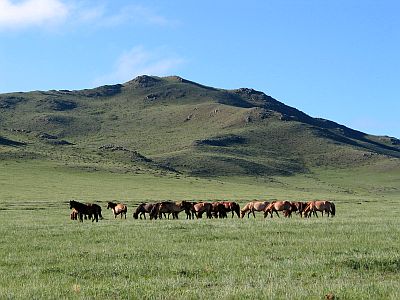 Summer
Summer in Mongolia is mild or cool in the north and at higher elevations, while it becomes warm to hot in the south and at lower elevations. In fact, the temperature is higher in the south and at low altitude. At 1,500 meters (5,000 feet) above sea level, the daily average in July is around 13 °C (55.5 °F) in the far north, around 15 °C (59 °F) in the center-north, and 20 °C (68 °F) in the south. At 1,000 meters (3,300 feet), the daily average ranges from 16 °C (61 °F) in the north to 24 °C (75 °F) in the south.
So, only at the lowest altitudes and in the south, the summer can be considered hot. The areas located at low altitudes, around a thousand meters or less, are not very large, so the summer nights in most of Mongolia are generally cool (sometimes even cold) and the days are pleasant.
However, in the whole country,
heat waves can occur, with peaks of 35/37 °C (95/99 °F), at least below 1,500 meters (5,000 feet).
The plateau
Ulaanbaatar
£graf-Ulan Bator
The capital, Ulaanbaatar (Ulan Bator), is located in the north, 1,300 meters (4,250 feet) above sea level.
During winter, Ulaanbaatar is
the coldest capital in the world, having an average in January of -23 °C (-9.5 °F) at the airport (in the city, the night temperatures are a few degrees higher, especially in winter). The minimum temperature at night drops easily below -35 °C (-31 °F); in January 2012, it dropped below -40 °C (-40 °F) for a consecutive week, with a low of -44 °C (-47 °F), while in January 2001, it reached -45 °C (-49 °F).
During winter,
snowfalls occur frequently, but they are light. The sky is often clear, although in the coldest hours, mists may form.
In April and October, the daily average is around 0 °C (32 °F). In May and September, lows are around freezing (0 °C or 32 °F) and highs around 15 °C (59 °F), but given the climatic variability, sometimes, there can be intense frosts even in these months.
Summer is pleasant: highs in July and August are about 25.5 °C (78 °F), with very cool nights, around 11 °C (52 °F). Occasionally, it can get cold even in summer, while during the day, it can get hot: the temperature rarely exceeds 32/33 °C (90/91 °F), but it can sometimes reach 37/38 °C (99/100 °F).
Ulaanbaatar is
relatively rainy, not only for the northern position, but also for its proximity to the mountains (the Khentii Mountains in the north and a single mountain,
Bogd Khan, in the south), in fact, it receives about 270 mm (10.5 in) of rain or snow per year.
Summer is the rainiest season: from June to August, more than 50 mm (2 in) of rain fall per month, usually in the form of showers in the afternoon.
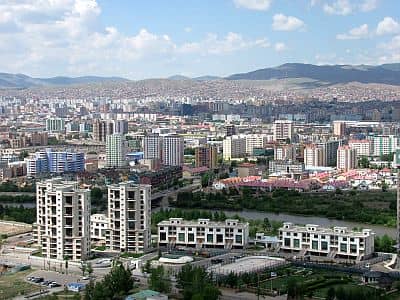
Altay
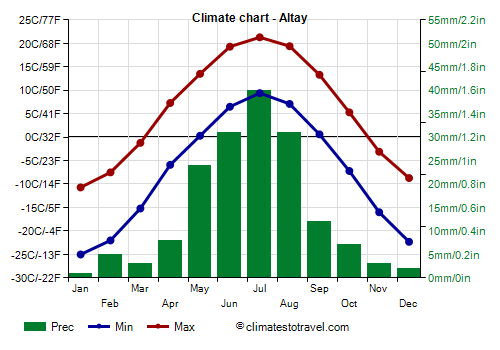
At higher altitudes, the summer temperatures are cooler. For example, in
Altay, a city located in the west, at 2,200 meters (7,200 ft) above sea level, the average temperature ranges from -18 °C in January to 15.5 °C in July. The coldest record is -40 °C (-40 °F) and was set in January 1977 and in February 2005. At night, the temperature can drop to around 0 °C (32 °F) even in July and August.
Mountains and lakes
In addition to the plateau, in Mongolia, there are
mountain ranges: in the west, we find the Altay Mountains, whose highest point is Hüiten Peak, 4,374 meters (14,350 feet) high; in the west-central, we find the Khangai Mountains, which reach 4,000 meters (13,000 ft); while north of the capital, we find the aforementioned Khentii Mountains, which reach 2,800 meters (9,200 ft).
The mountainous areas are those that receive the most abundant rainfall, and they are practically the only ones where you can find forests.
Above 3,500 meters (11,500 ft), there are glaciers and snowfields, while at altitudes a bit lower, above 2,000 meters (6,500 feet), it can sometimes snow even in summer.
In Mongolia, there are several
lakes, some of which are large enough to influence the local climate. In winter, of course, the lakes freeze.
The largest lake,
Uvs, is located in the far north-west, at 760 metres (2,500 feet), in a desert area, where the average temperature in July is around 19 °C (66 °F).
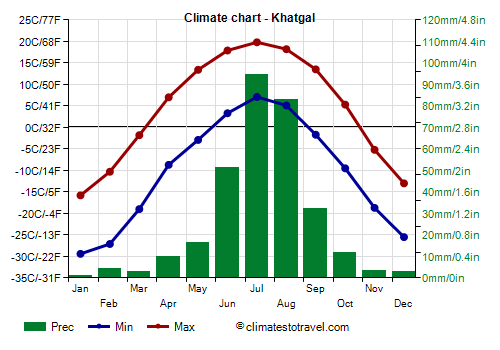
The second lake,
Khovsgol, is located in the north at 1,650 meters (5,400 feet), in a greener area, and given the high altitude and the size of the lake, on the banks, it's very cool or cold even in summer. In
Khatgal, on the southern shore of the lake, in July there is a minimum of 7 °C (44.5 °F) and a maximum of 20 °C (68 °F).
Precipitation amounts to 315 mm (12.5 in) per year, therefore we are in the rainiest area of Mongolia.
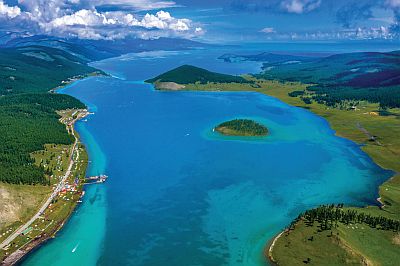
The third lake,
Khar-Us, is located in the west at 1,150 meters (3,800 feet) above sea level, in a desert area.
Gobi Desert
The Gobi Desert is located in the south. In winter it is the mildest part of Mongolia, but the temperatures are very low. In summer, temperatures in this area are high, in fact, below 1,000 meters (3,300 feet) of altitude, highs in July reach or exceed 30 °C (86 °F). In addition, there may be heat waves, during which the temperature reaches 38/40 °C (100/104 °F).
Sainshand
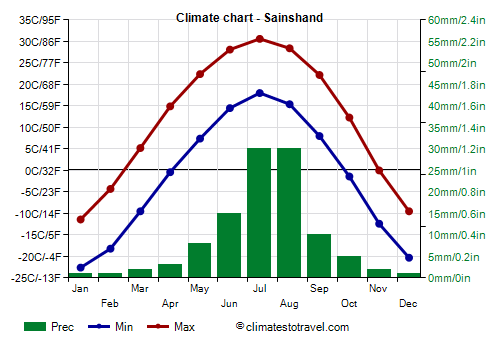
For example, in
Sainshand, located in the south-east, at 950 meters (3,100 ft) above sea level, the average temperature ranges from -17 °C (1.5 °F) in January to 24.3 °C (75.7 °F) in July.
Although it is drier than the north, the Gobi Desert receives some
rain showers in summer, able to feed some grass as well as the camels, at least in the eastern part, where from 150 to 200 mm (6 to 8 in) of rain fall per year.
The most arid area is the south-west, where precipitation drops below 100 mm (4 in) per year, and in some cases even below 50 mm (2 in).
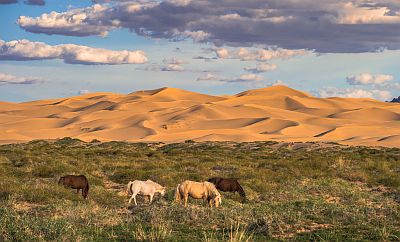
When to go
The best time to visit Mongolia is the
summer, from June to August, when the temperature remains above freezing even at night, at least in the plateau and in the mountains at low altitude.
It is true that summer is the rainiest period of the year, and it can get hot during the day, especially in the center and south and at lower altitudes, but at least, in this way you avoid the bitter cold. However, in summer, it can even get cold at night, so you have to be ready to cover and uncover, depending on hour and weather conditions, in addition, it is advisable to bring a scarf, for wind and dust protection.
What to pack
In
winter, it is necessary to bring clothes for the great cold, such as synthetic, thermal and long underwear, a fleece, a parka, a wind jacket, a hat, gloves, and warm boots.
In
summer, bring spring/autumn clothes, T-shirts for hot days, but also a long jacket for the wind, a sweater or sweatshirt for the evening and at high altitudes, a raincoat or umbrella, a scarf for the wind-borne dust, hiking shoes, sunscreen, and sunglasses. For high mountains, a down jacket, a hat, gloves, and a scarf. A sleeping bag and a warm jacket for outdoor overnight stays.
Climate data - Mongolia
| Altay (2,200 meters) |
|---|
|
| Jan | Feb | Mar | Apr | May | Jun | Jul | Aug | Sep | Oct | Nov | Dec |
|---|
| Min temp. | -25 | -22 | -15 | -6 | 0 | 6 | 9 | 7 | 1 | -7 | -16 | -22 |
|---|
| Max temp. | -11 | -8 | -1 | 7 | 14 | 19 | 21 | 19 | 13 | 5 | -3 | -9 |
|---|
| Precip. | 0 | 5 | 5 | 10 | 25 | 30 | 40 | 30 | 10 | 5 | 5 | 0 |
|---|
| Prec. days | 1 | 2 | 2 | 2 | 4 | 6 | 7 | 6 | 4 | 3 | 2 | 2 |
|---|
|
|
|
|
| Baruun-Urt (975 meters) |
|---|
|
| Jan | Feb | Mar | Apr | May | Jun | Jul | Aug | Sep | Oct | Nov | Dec |
|---|
| Min temp. | -26 | -22 | -12 | -2 | 5 | 12 | 16 | 13 | 6 | -3 | -15 | -23 |
|---|
| Max temp. | -16 | -10 | 1 | 12 | 20 | 26 | 28 | 26 | 20 | 10 | -3 | -13 |
|---|
| Precip. | 0 | 0 | 0 | 5 | 15 | 40 | 50 | 40 | 15 | 5 | 5 | 0 |
|---|
| Prec. days | 1 | 1 | 1 | 2 | 4 | 6 | 8 | 6 | 4 | 2 | 2 | 2 |
|---|
|
|
| Sun hours | 7 | 8 | 8 | 9 | 10 | 10 | 10 | 9 | 9 | 8 | 7 | 6 |
|---|
|
| Choibalsan (745 meters) |
|---|
|
| Jan | Feb | Mar | Apr | May | Jun | Jul | Aug | Sep | Oct | Nov | Dec |
|---|
| Min temp. | -25 | -21 | -12 | -2 | 5 | 12 | 16 | 13 | 6 | -3 | -14 | -22 |
|---|
| Max temp. | -14 | -9 | 0 | 12 | 20 | 26 | 28 | 26 | 20 | 9 | -3 | -12 |
|---|
| Precip. | 0 | 0 | 5 | 5 | 15 | 35 | 65 | 60 | 25 | 10 | 5 | 5 |
|---|
| Prec. days | 1 | 2 | 2 | 2 | 3 | 6 | 9 | 7 | 5 | 2 | 2 | 2 |
|---|
|
|
| Sun hours | 6 | 8 | 9 | 9 | 10 | 10 | 10 | 9 | 9 | 8 | 7 | 6 |
|---|
|
| Dalanzadgad (1,470 meters) |
|---|
|
| Jan | Feb | Mar | Apr | May | Jun | Jul | Aug | Sep | Oct | Nov | Dec |
|---|
| Min temp. | -19 | -15 | -8 | -1 | 8 | 14 | 17 | 15 | 9 | 0 | -10 | -17 |
|---|
| Max temp. | -7 | -2 | 6 | 15 | 21 | 27 | 29 | 27 | 21 | 12 | 3 | -5 |
|---|
| Precip. | 0 | 0 | 5 | 5 | 10 | 20 | 30 | 30 | 10 | 5 | 5 | 5 |
|---|
| Prec. days | 1 | 1 | 2 | 2 | 3 | 4 | 5 | 4 | 3 | 2 | 2 | 2 |
|---|
|
|
| Sun hours | 8 | 8 | 8 | 9 | 10 | 10 | 9 | 10 | 9 | 9 | 8 | 7 |
|---|
|
| Darkhan (700 meters) |
|---|
|
| Jan | Feb | Mar | Apr | May | Jun | Jul | Aug | Sep | Oct | Nov | Dec |
|---|
| Min temp. | -30 | -26 | -14 | -4 | 3 | 9 | 13 | 10 | 3 | -5 | -17 | -26 |
|---|
| Max temp. | -17 | -10 | 1 | 13 | 22 | 27 | 28 | 26 | 20 | 11 | -3 | -13 |
|---|
| Precip. | 5 | 5 | 5 | 10 | 20 | 50 | 65 | 65 | 35 | 10 | 5 | 5 |
|---|
| Prec. days | 7 | 5 | 4 | 6 | 8 | 12 | 14 | 12 | 8 | 6 | 7 | 8 |
|---|
|
|
|
|
| Erdenet (1,280 meters) |
|---|
|
| Jan | Feb | Mar | Apr | May | Jun | Jul | Aug | Sep | Oct | Nov | Dec |
|---|
| Min temp. | -24 | -22 | -16 | -6 | 1 | 6 | 9 | 7 | 1 | -7 | -16 | -22 |
|---|
| Max temp. | -10 | -8 | -2 | 7 | 14 | 19 | 21 | 19 | 14 | 6 | -3 | -8 |
|---|
| Precip. | 0 | 0 | 5 | 10 | 15 | 30 | 45 | 40 | 15 | 10 | 5 | 0 |
|---|
| Prec. days | 4 | 4 | 6 | 7 | 8 | 10 | 13 | 11 | 6 | 6 | 5 | 4 |
|---|
|
|
|
|
| Khanbogd (1,100 meters) |
|---|
|
| Jan | Feb | Mar | Apr | May | Jun | Jul | Aug | Sep | Oct | Nov | Dec |
|---|
| Min temp. | -16 | -13 | -6 | 3 | 10 | 16 | 19 | 17 | 11 | 2 | -7 | -14 |
|---|
| Max temp. | -6 | -1 | 7 | 16 | 24 | 29 | 31 | 29 | 23 | 14 | 4 | -4 |
|---|
| Precip. | 0 | 0 | 5 | 5 | 10 | 15 | 25 | 30 | 10 | 5 | 0 | 0 |
|---|
| Prec. days | 2 | 2 | 3 | 3 | 4 | 6 | 8 | 8 | 4 | 2 | 2 | 2 |
|---|
|
|
|
|
| Kharkhorin (1,450 meters) |
|---|
|
| Jan | Feb | Mar | Apr | May | Jun | Jul | Aug | Sep | Oct | Nov | Dec |
|---|
| Min temp. | -22 | -18 | -11 | -2 | 4 | 10 | 12 | 10 | 4 | -4 | -12 | -19 |
|---|
| Max temp. | -11 | -6 | 2 | 11 | 18 | 23 | 24 | 23 | 18 | 9 | -1 | -9 |
|---|
| Precip. | 5 | 5 | 10 | 15 | 30 | 60 | 80 | 50 | 20 | 15 | 5 | 5 |
|---|
| Prec. days | 5 | 4 | 7 | 7 | 10 | 14 | 16 | 14 | 8 | 6 | 5 | 5 |
|---|
|
|
|
|
| Khatgal (1,700 meters) |
|---|
|
| Jan | Feb | Mar | Apr | May | Jun | Jul | Aug | Sep | Oct | Nov | Dec |
|---|
| Min temp. | -29 | -27 | -19 | -9 | -3 | 3 | 7 | 5 | -2 | -10 | -19 | -26 |
|---|
| Max temp. | -16 | -10 | -2 | 7 | 13 | 18 | 20 | 18 | 14 | 5 | -5 | -13 |
|---|
| Precip. | 0 | 5 | 5 | 10 | 15 | 50 | 95 | 85 | 30 | 10 | 5 | 5 |
|---|
| Prec. days | 1 | 0 | 1 | 2 | 3 | 8 | 11 | 10 | 6 | 2 | 1 | 0 |
|---|
|
|
| Sun hours | 6 | 7 | 9 | 9 | 10 | 10 | 9 | 8 | 8 | 7 | 6 | 5 |
|---|
|
| Khovd (1,400 meters) |
|---|
|
| Jan | Feb | Mar | Apr | May | Jun | Jul | Aug | Sep | Oct | Nov | Dec |
|---|
| Min temp. | -28 | -23 | -12 | -1 | 6 | 12 | 14 | 12 | 5 | -3 | -14 | -23 |
|---|
| Max temp. | -16 | -10 | 3 | 13 | 20 | 25 | 26 | 25 | 19 | 10 | -1 | -12 |
|---|
| Precip. | 0 | 0 | 5 | 5 | 15 | 25 | 30 | 25 | 10 | 5 | 0 | 0 |
|---|
| Prec. days | 1 | 2 | 2 | 2 | 3 | 5 | 6 | 5 | 2 | 2 | 1 | 2 |
|---|
|
|
| Sun hours | 6 | 7 | 8 | 9 | 10 | 10 | 10 | 10 | 9 | 7 | 6 | 5 |
|---|
|
| Mandalgovi (1,400 meters) |
|---|
|
| Jan | Feb | Mar | Apr | May | Jun | Jul | Aug | Sep | Oct | Nov | Dec |
|---|
| Min temp. | -22 | -19 | -11 | -2 | 5 | 12 | 15 | 13 | 6 | -3 | -13 | -20 |
|---|
| Max temp. | -11 | -6 | 3 | 12 | 20 | 25 | 27 | 25 | 19 | 10 | -1 | -9 |
|---|
| Precip. | 0 | 0 | 0 | 5 | 10 | 20 | 40 | 40 | 10 | 5 | 0 | 0 |
|---|
| Prec. days | 2 | 1 | 1 | 2 | 2 | 4 | 6 | 6 | 2 | 2 | 2 | 1 |
|---|
|
|
|
|
| Moron (1,285 meters) |
|---|
|
| Jan | Feb | Mar | Apr | May | Jun | Jul | Aug | Sep | Oct | Nov | Dec |
|---|
| Min temp. | -28 | -24 | -14 | -5 | 3 | 9 | 12 | 9 | 2 | -6 | -16 | -24 |
|---|
| Max temp. | -15 | -8 | 2 | 11 | 19 | 24 | 25 | 23 | 17 | 8 | -3 | -12 |
|---|
| Precip. | 0 | 0 | 0 | 5 | 20 | 50 | 75 | 60 | 20 | 5 | 0 | 5 |
|---|
| Prec. days | 4 | 3 | 4 | 6 | 10 | 17 | 21 | 17 | 10 | 5 | 4 | 4 |
|---|
|
|
| Sun hours | 5 | 7 | 8 | 8 | 10 | 10 | 9 | 9 | 8 | 7 | 6 | 5 |
|---|
|
| Sainshand (900 meters) |
|---|
|
| Jan | Feb | Mar | Apr | May | Jun | Jul | Aug | Sep | Oct | Nov | Dec |
|---|
| Min temp. | -23 | -18 | -10 | 0 | 7 | 14 | 18 | 15 | 8 | -1 | -12 | -20 |
|---|
| Max temp. | -11 | -4 | 5 | 15 | 22 | 28 | 31 | 28 | 22 | 12 | 0 | -10 |
|---|
| Precip. | 0 | 0 | 0 | 5 | 10 | 15 | 30 | 30 | 10 | 5 | 0 | 0 |
|---|
| Prec. days | 0 | 0 | 0 | 1 | 2 | 3 | 5 | 4 | 2 | 1 | 1 | 0 |
|---|
|
|
|
|
| Sukhbaatar (625 meters) |
|---|
|
| Jan | Feb | Mar | Apr | May | Jun | Jul | Aug | Sep | Oct | Nov | Dec |
|---|
| Min temp. | -28 | -24 | -13 | -3 | 4 | 10 | 14 | 12 | 4 | -4 | -14 | -23 |
|---|
| Max temp. | -17 | -10 | 1 | 12 | 20 | 25 | 27 | 24 | 18 | 9 | -4 | -14 |
|---|
| Precip. | 5 | 0 | 5 | 10 | 25 | 50 | 70 | 70 | 35 | 10 | 5 | 5 |
|---|
| Prec. days | 7 | 4 | 6 | 6 | 10 | 14 | 17 | 15 | 11 | 6 | 7 | 7 |
|---|
|
|
|
|
| Ulaanbaatar (1,305 meters) |
|---|
|
| Jan | Feb | Mar | Apr | May | Jun | Jul | Aug | Sep | Oct | Nov | Dec |
|---|
| Min temp. | -26 | -22 | -13 | -3 | 4 | 10 | 14 | 11 | 4 | -4 | -15 | -23 |
|---|
| Max temp. | -16 | -9 | 0 | 10 | 18 | 23 | 25 | 23 | 17 | 8 | -5 | -14 |
|---|
| Precip. | 0 | 5 | 5 | 10 | 20 | 45 | 70 | 60 | 25 | 5 | 5 | 5 |
|---|
| Prec. days | 0 | 0 | 0 | 3 | 8 | 14 | 17 | 15 | 9 | 2 | 0 | 0 |
|---|
|
|
| Sun hours | 5 | 7 | 8 | 9 | 10 | 9 | 9 | 9 | 8 | 7 | 6 | 4 |
|---|
|
| Ulaangom (950 meters) |
|---|
|
| Jan | Feb | Mar | Apr | May | Jun | Jul | Aug | Sep | Oct | Nov | Dec |
|---|
| Min temp. | -36 | -34 | -24 | -4 | 4 | 10 | 13 | 10 | 4 | -4 | -14 | -29 |
|---|
| Max temp. | -25 | -22 | -10 | 8 | 20 | 25 | 26 | 24 | 17 | 8 | -5 | -19 |
|---|
| Precip. | 0 | 0 | 5 | 5 | 5 | 30 | 45 | 30 | 10 | 10 | 10 | 5 |
|---|
| Prec. days | 5 | 4 | 5 | 4 | 6 | 10 | 14 | 12 | 6 | 5 | 14 | 11 |
|---|
|
|
| Sun hours | 4 | 6 | 8 | 9 | 10 | 11 | 10 | 10 | 8 | 6 | 3 | 3 |
|---|
|
| Uliastai (1,750 meters) |
|---|
|
| Jan | Feb | Mar | Apr | May | Jun | Jul | Aug | Sep | Oct | Nov | Dec |
|---|
| Min temp. | -28 | -26 | -17 | -5 | 1 | 7 | 10 | 7 | 1 | -7 | -18 | -25 |
|---|
| Max temp. | -15 | -10 | -2 | 9 | 17 | 22 | 24 | 21 | 16 | 7 | -5 | -13 |
|---|
| Precip. | 5 | 5 | 5 | 10 | 15 | 35 | 60 | 50 | 25 | 10 | 5 | 5 |
|---|
| Prec. days | 6 | 5 | 6 | 7 | 10 | 14 | 17 | 14 | 8 | 6 | 7 | 6 |
|---|
|
|
|
|
| Zamyn-Uud (965 meters) |
|---|
|
| Jan | Feb | Mar | Apr | May | Jun | Jul | Aug | Sep | Oct | Nov | Dec |
|---|
| Min temp. | -24 | -20 | -11 | -1 | 7 | 14 | 17 | 15 | 8 | -1 | -12 | -21 |
|---|
| Max temp. | -12 | -8 | 5 | 15 | 23 | 28 | 30 | 28 | 22 | 13 | 1 | -9 |
|---|
| Precip. | 0 | 0 | 0 | 5 | 10 | 20 | 30 | 35 | 10 | 5 | 0 | 0 |
|---|
| Prec. days | 3 | 3 | 3 | 2 | 4 | 8 | 9 | 8 | 5 | 3 | 3 | 4 |
|---|
|
|
|
|
See also the
temperatures month by month